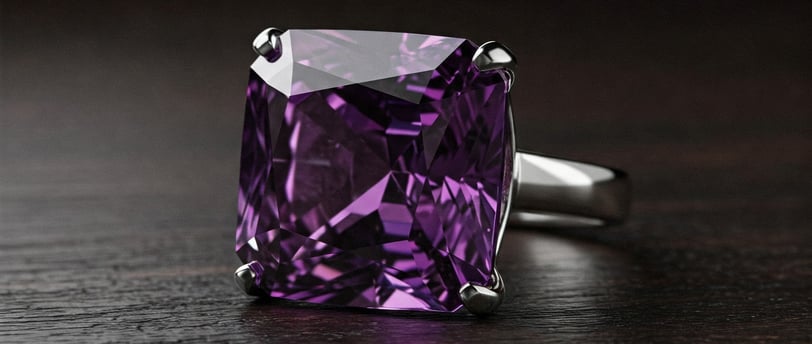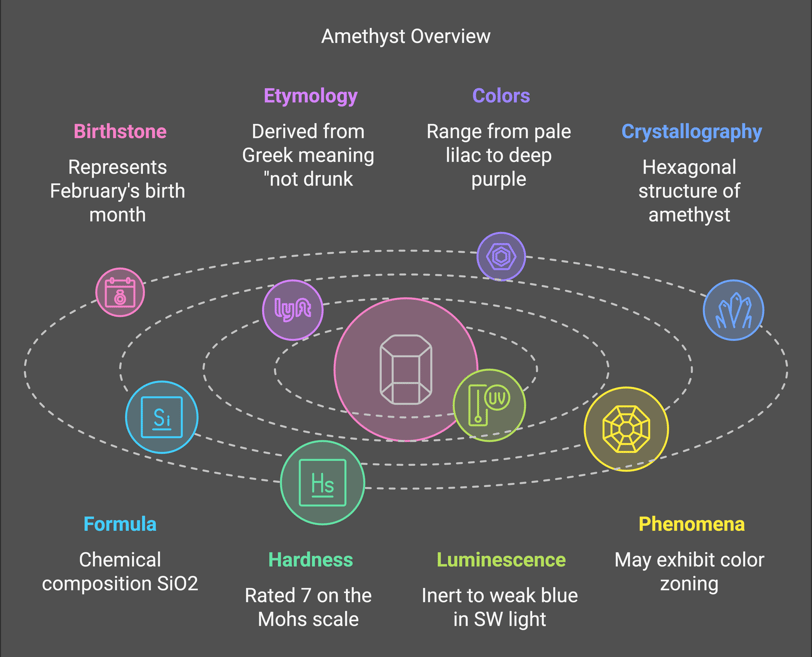Amethyst
Explore the world of amethyst, a beautiful and affordable gemstone with a long history, known for its varying shades of purple, and discover its quality factors, and tips for care and purchase.
1/30/20253 min read


History
Amethyst, a captivating gemstone with a rich history, is a variety of quartz that has been prized for thousands of years. It is the February birthstone and is also used to celebrate the 6th and 17th wedding anniversaries. Ancient Egyptians carved amethysts into animal shapes, possibly as protective amulets. The Ancient Greeks believed amethyst could prevent drunkenness, with the name 'amethystos' meaning 'not drunk' in Greek. The gemstone has been associated with romance and spirituality, with Christian scholars referring to it as "the bishop’s stone" for its power to provide clarity and sobriety, and Buddhist monks using it to make prayer beads. It is a gem that is both beautiful and affordable, making it suitable for both high-end designer pieces and everyday jewellery.
Mineral Origins
Amethyst is a crystalline quartz, found in a variety of locations around the world. Major sources include Brazil, Bolivia, Uruguay, and Zambia. Brazil produces large stones, often with moderate colour, while Zambia and Uruguay are known for producing smaller stones with richer, darker colours. Amethyst can also be found in the United States, including in Arizona, and in Canada. The gem is typically found in pegmatites and veins, and in geodes within alluvial deposits. The colour of amethyst is due to the presence of iron and other trace elements as well as natural irradiation. Amethyst may exhibit colour zoning, with uneven colour distribution or intentional colour bands.
The 4 C's
Colour
The most important factor in determining the value of an amethyst is its colour. The finest amethyst displays a strong reddish-purple to purple hue, with no visible colour zoning when viewed from above. Any brownish or bronze-coloured tints or noticeable colour zoning will lower its value. The intensity of the colour is important, with dealers preferring strongly saturated reddish purple to dark purple, but not so dark that it reduces brightness or appears black under dim lighting. Lighter, pastel shades of amethyst are sometimes called “Rose de France”. Amethyst is sensitive to lighting, appearing deeper purple in evening light and cooler grayish-blue in daylight.
Clarity
Most faceted amethyst on the market is "eye-clean," meaning it lacks inclusions visible to the naked eye. Minor inclusions may be overlooked if the gem has a rich colour. However, visible inclusions in pale gemstones will reduce their value. Amethysts with visible inclusions but attractive colour are often cut as cabochons or fashioned into beads. African amethyst, particularly from Zambia, tends to have more inclusions than Brazilian material, though its saturated raspberry colour can still be acceptable in a faceted stone.
Carat
Amethyst is available in a wide range of sizes, and unlike some other coloured gemstones, its price per carat does not increase dramatically with larger sizes. This makes it a popular choice for large centre stones in jewellery. Both small and large amethysts can have strong colour, making it easier to match sets of differently sized stones.
Cut
Amethysts are cut into a variety of shapes, including rounds, ovals, pears, emerald cuts, triangles, marquises, and cushions, as well as custom and freeform shapes. Facet patterns include brilliant cuts, step cuts, and mixed cuts. Skilled cutters may also create fantasy or designer cuts, with concave facets. The quality of the cut impacts the beauty and brilliance of the gem, with well-cut amethysts reflecting light evenly and sparkling in a lively way.
Be Aware of
Enhancements
Amethyst can be heat treated to lighten its colour or change it to citrine or other colours. Heat treatment is usually permanent and will not fade. Very dark amethyst can be lightened with heat treatments, but heating amethysts to 400-500º C may turn it brown, red or green, which is then known as prasiolite. Lower quality, light-coloured amethysts and quartz may be dyed purple.
Simulants
Amethysts may look similar to sapphires, spinels, and rhodolite garnets, though these are less likely to be found in purple colours. These gemstones have different optical and physical properties such as higher refractive indices and specific gravity values.
Synthetics
Synthetic amethysts can be grown in labs, and also created by bombarding specially prepared smoky quartz with gamma rays. Since natural amethyst is abundant and relatively inexpensive, there is little incentive to purchase synthetics, though synthetic rough material is sometimes sold as natural rough. Gemologists can easily distinguish between natural and synthetic amethyst.
Final Thoughts
Buying Tips
When buying amethyst, it is important to understand the difference that colour makes, as pale colours are more affordable than strong reddish purple tones. Do not compromise on cut, ensuring the gem sparkles evenly and reflects light well. It is advisable to work with a trusted jeweller who has gemological knowledge. For significant purchases, an independent laboratory report can verify that the amethyst is natural. Though origin does not add value, some prefer the colour of amethysts from specific locations.
Jewellery Care
Amethyst is durable enough for everyday wear, but it can still show wear over time and may require repolishing. It is also sensitive to extreme heat. Clean amethyst jewellery with warm soapy water and a soft brush, avoiding mechanical cleaning systems and ultrasonic cleaners. Clean regularly to prevent build-up of cosmetics and dirt that can affect brilliance.


Gemius Stones
Expertise
© 2025. All rights reserved.
